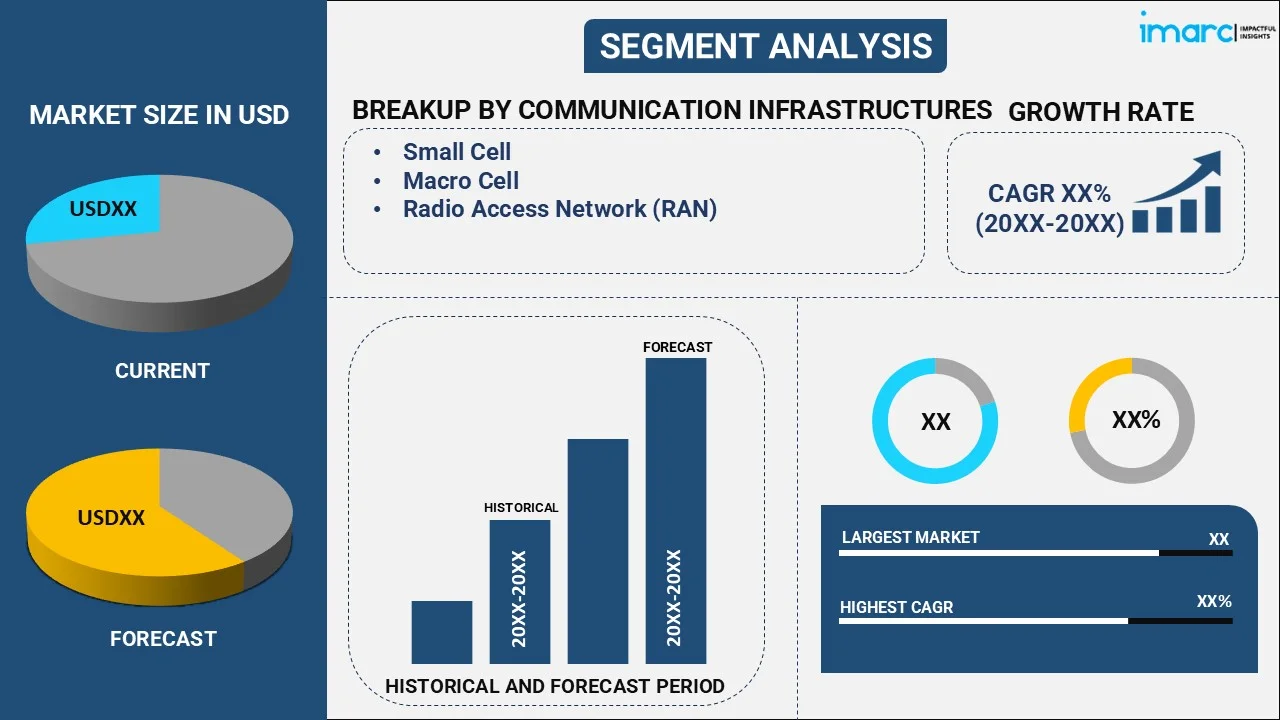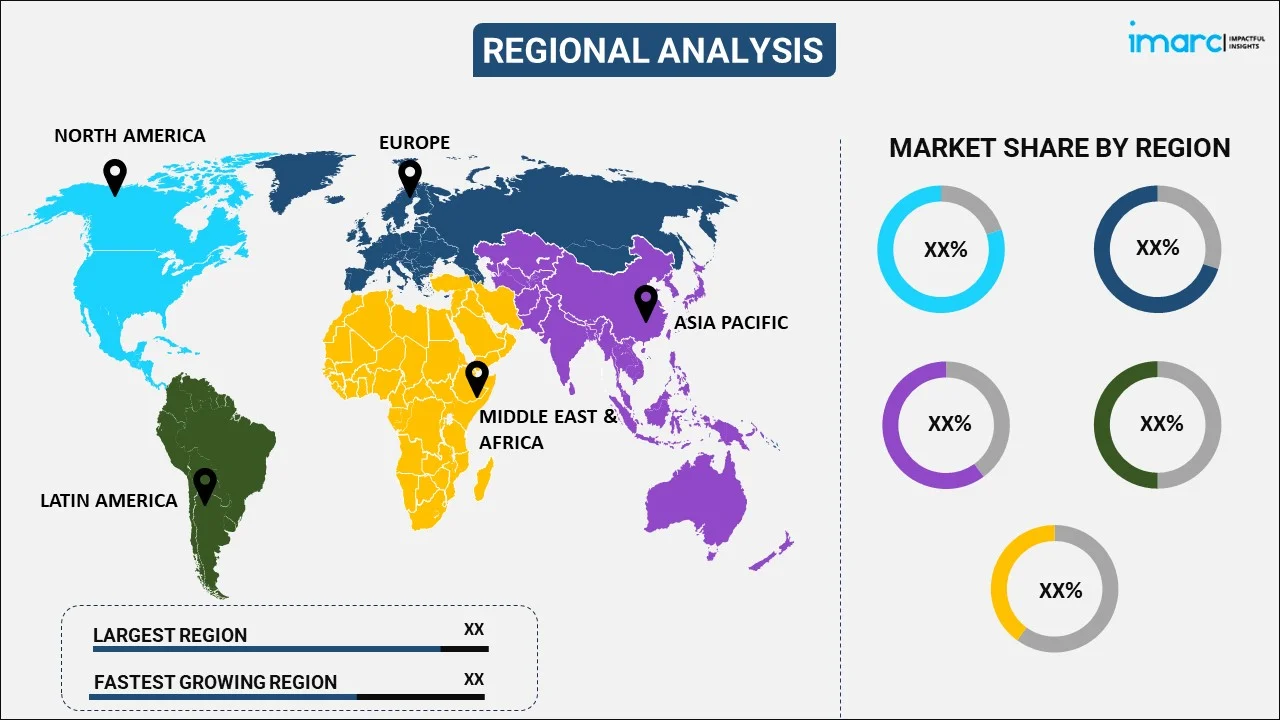
5G in Defense Market Report by Communication Infrastructure (Small Cell, Macro Cell, Radio Access Network (RAN)), Core Network Technology (Software-Defined Networking (SDN), Fog Computing (FC), Mobile Edge Computing (MEC), Network Functions Virtualization (NFV)), Network Type (Enhanced Mobile Broadband (EMBB), Ultra-Reliable Low-Latency Communications (URLLC), Massive Machine Type Communications (MMTC)), Chipset (Application-Specific Integrated Circuit (ASIC) Chipset, Radio Frequency Integrated Circuit (RFIC) Chipset, Millimeter Wave (mmWave) Chipset), Platform (Land, Naval, Airborne), and Region 2025-2033
Market Overview:
The global 5G in defense market size reached USD 2,338.6 Million in 2024. Looking forward, the market is expected to reach USD 42,556.2 Million by 2033, exhibiting a growth rate (CAGR) of 36.14% during 2025-2033.
|
Report Attribute
|
Key Statistics
|
|---|---|
|
Base Year
|
2024
|
|
Forecast Years
|
2025-2033
|
|
Historical Years
|
2019-2024
|
| Market Size in 2024 | USD 2,338.6 Million |
| Market Forecast in 2033 | USD 42,556.2 Million |
| Market Growth Rate 2025-2033 | 36.14% |
5G refers to the fifth-generation mobile network technology that carries wireless communication and connects objects, machines, people, and devices. It comprises various networks, such as enhanced mobile broadband (eMBB), massive machine type communication (MMTC), and ultra-reliable low-latency communications (URLLC). Consequently, it finds widespread applications across various industries. For instance, particularly in the defense sector, 5G is widely used to improve and process intelligence, surveillance, and reconnaissance (ISR) systems, streamline logistics systems and enable new methods of command and control (C2). It further assists in quick response time and faster transmission of videos and images to achieve real-time battlefield results. The network is also widely used to provide enemy infantry real-time operation information at inconvenient, dangerous, and remote areas. It is also utilized to transmit data over various wireless broadband connections to enhance speed and bandwidth at a multigigabit speed. It also offers ultra-low latency, enhanced network capacity, uniform user experience, high-speed data, and increased reliability.
5G in Defense Market Trends:
The widespread adoption of autonomous defense vehicles and robots in the defense sector is one of the key factors primarily driving the market growth. Additionally, the rising use of 5G in radars to detect and track multiple targets and the surging numbers of cross-border and territorial conflicts are favoring the market growth. Moreover, various technological advancements, such as the integration of the Internet of Things (IoT), which enables the communication between multiple sensors and connected devices and facilitates high-speed data connectivity, are boosting the market growth. 5G services are rapidly being adopted in augmented reality (AR) for efficient maintenance of gadgets, vehicles, and equipment to train military personnel, which is positively impacting the market growth. Apart from this, the rapid upgradation of defense infrastructure and the implementation of various government initiatives to support 5G technology are some of the factors creating a positive outlook for the market.
Key Market Segmentation:
IMARC Group provides an analysis of the key trends in each sub-segment of the global 5G in defense market report, along with forecasts at the global, regional and country level from 2025-2033. Our report has categorized the market based on communication infrastructure, core network technology, network type, chipset and platform.
Breakup by Communication Infrastructure:

- Small Cell
- Macro Cell
- Radio Access Network (RAN)
Breakup by Core Network Technology:
- Software-Defined Networking (SDN)
- Fog Computing (FC)
- Mobile Edge Computing (MEC)
- Network Functions Virtualization (NFV)
Breakup by Network Type:
- Enhanced Mobile Broadband (EMBB)
- Ultra-Reliable Low-Latency Communications (URLLC)
- Massive Machine Type Communications (MMTC)
Breakup by Chipset:
- Application-Specific Integrated Circuit (ASIC) Chipset
- Radio Frequency Integrated Circuit (RFIC) Chipset
- Millimeter Wave (mmWave) Chipset
Breakup by Platform:
- Land
- Naval
- Airborne
Breakup by Region:

- North America
- United States
- Canada
- Asia-Pacific
- China
- Japan
- India
- South Korea
- Australia
- Indonesia
- Others
- Europe
- Germany
- France
- United Kingdom
- Italy
- Spain
- Russia
- Others
- Latin America
- Brazil
- Mexico
- Others
- Middle East and Africa
Competitive Landscape:
The report provides a comprehensive analysis of the competitive landscape in the global 5G in defense market with detailed profiles of all major companies, including:
- General Dynamics Information Technology
- Lockheed Martin Corporation
- Nokia Corporation
- Samsung Electronics Co., Ltd.
- Sierra Wireless (Semtech Corporation)
- Telefonaktiebolaget LM Ericsson
- Thales Group
- Wind River Systems, Inc.
Report Coverage:
| Report Features | Details |
|---|---|
| Base Year of the Analysis | 2024 |
| Historical Period | 2019-2024 |
| Forecast Period | 2025-2033 |
| Units | Million USD |
| Segment Coverage | Communication Infrastructure, Core Network Technology, Network Type, Chipset, Platform, Region |
| Region Covered | Asia Pacific, Europe, North America, Latin America, Middle East and Africa |
| Countries Covered | United States, Canada, Germany, France, United Kingdom, Italy, Spain, Russia, China, Japan, India, South Korea, Australia, Indonesia, Brazil, Mexico |
| Companies Covered | General Dynamics Information Technology, Lockheed Martin Corporation, Nokia Corporation, Samsung Electronics Co., Ltd., Sierra Wireless (Semtech Corporation), Telefonaktiebolaget LM Ericsson, Thales Group, Wind River Systems, Inc., etc. |
| Customization Scope | 10% Free Customization |
| Post-Sale Analyst Support | 10-12 Weeks |
| Delivery Format | PDF and Excel through Email (We can also provide the editable version of the report in PPT/Word format on special request) |
Key Questions Answered in This Report
The global 5G in defense market was valued at USD 2,338.6 Million in 2024.
We expect the global 5G in defense market to exhibit a CAGR of 36.14% during 2025-2033.
Continuous upgradation of defense infrastructures, along with the extensive utilization of 5G in radars to detect and track multiple targets, is currently driving the global 5G in defense market.
The sudden outbreak of the COVID-19 pandemic had led to the implementation of stringent lockdown regulations across several nations resulting in temporary halt in the development and testing of 5G technologies for the defense industry and supply chain disruption of crucial components.
Based on the communication infrastructure, the global 5G in defense market can be segregated into small cell, macro cell, and Radio Access Network (RAN). Currently, small cell accounts for the majority of the global market share.
Based on the core network technology, the global 5G in defense market has been divided into Software-Defined Networking (SDN), Fog Computing (FC), Mobile Edge Computing (MEC), and Network Functions Virtualization (NFV). Among these, Software-Defined Networking (SDN) currently exhibits a clear dominance in the market.
Based on the network type, the global 5G in defense market can be categorized into Enhanced Mobile Broadband (EMBB), Ultra-Reliable Low-Latency Communications (URLLC), and Massive Machine Type Communications (MMTC). Currently, Enhanced Mobile Broadband (EMBB) holds the majority of the total market share.
Based on the chipset, the global 5G in defense market has been segmented into Application-Specific Integrated Circuit (ASIC) chipset, Radio Frequency Integrated Circuit (RFIC) chipset, and Millimeter Wave (mmWave) chipset. Among these, Application-Specific Integrated Circuit (ASIC) chipset currently represents the largest market share.
Based on the platform, the global 5G in defense market can be bifurcated into land, naval, and airborne. Currently, land accounts for the majority of the global market share.
On a regional level, the market has been classified into North America, Europe, Asia-Pacific, Middle East and Africa, and Latin America, where North America currently dominates the global market.
Some of the major players in the global 5G in defense market include General Dynamics Information Technology, Lockheed Martin Corporation, Nokia Corporation, Samsung Electronics Co., Ltd., Sierra Wireless (Semtech Corporation), Telefonaktiebolaget LM Ericsson, Thales Group, and Wind River Systems, Inc.
Need more help?
- Speak to our experienced analysts for insights on the current market scenarios.
- Include additional segments and countries to customize the report as per your requirement.
- Gain an unparalleled competitive advantage in your domain by understanding how to utilize the report and positively impacting your operations and revenue.
- For further assistance, please connect with our analysts.
 Request Customization
Request Customization
 Speak to an Analyst
Speak to an Analyst
 Request Brochure
Request Brochure
 Inquire Before Buying
Inquire Before Buying




.webp)




.webp)












